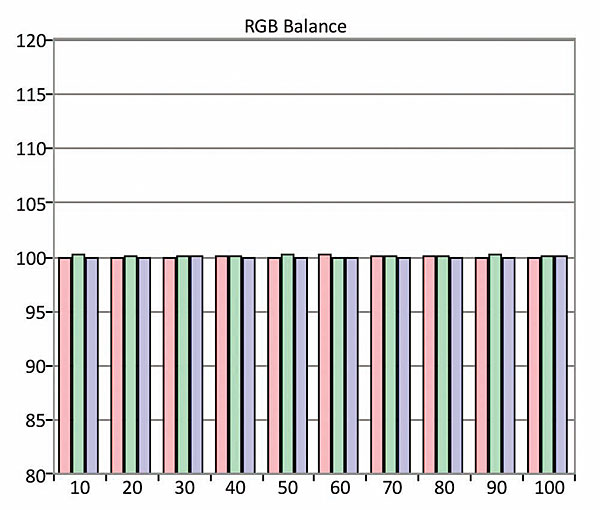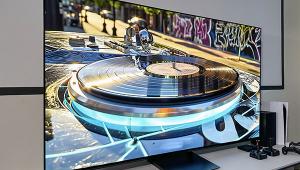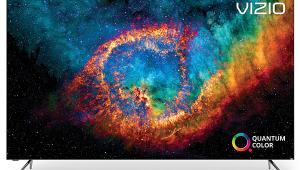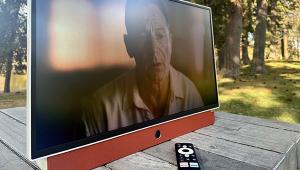Awesome. Now just need to wait for the inevitable 50% price reduction in the next 1-2 years.
LG 65EF9500 OLED Ultra HDTV Review Test Bench
Measurements were made using SpectraCal CalMAN measurement software, Photo Research PR-650 and Klein K-10A color meters, and AVFoundry VideoForge 2K and DVDO 4K pattern generators. All calibrations were performed in 1080p and Rec. 709.
Full-On/Full-Off Contrast Ratio: Unmeasurable
At a peak white light output of 50 ft-L (Expert1 Picture Mode, LED Light at 50, Contrast at 75, Brightness at 49), the black level couldn’t be measured (in effect, it was totally black).


On a white window test pattern, the peak available light output I measured in the Expert1 Picture Mode, with both the OLED Light and Contrast controls set to 100 (maximum), was 113 ft-L (387 nits) on both 2% and 18% white window patterns and 36 ft-L (123 nits) with 100% full screen peak white (OLEDs respond much like plasmas in this respect). No other mode, even Vivid, produced a higher peak white level, and in any case, only the Expert modes offered the fullest range of white balance and color management controls. This is roughly half the peak white level we recently measured on Vizio’s RS65-B2—and the latter can maintain this peak level on a full white screen.
In the Expert1 mode, adjusted for just over 50 ft-L peak white, the pre-calibration grayscale Delta E values (20 to 100%) ranged from a low of 0.92 at 70% to a high of 3.15 at 100%. After calibration, using both the 2-point and 20-point white balance controls, the Delta Es ranged from 0.13 at 100% to 2.27 at 30%.
Pre-calibration, the color Delta Es ranged from 0.51 on green to 2.94 on blue. After calibration, the only value higher than 0.60 was blue at 2.78. These readings were taken prior to a subjective readjustment of the blue luminance from the calibrated value of –30 (which caused visible issues) to a setting of 5 (which worked far better).
(Delta E is a figure of merit that indicates how closely a display adheres to the color standard. Experts generally agree that at levels below 3 to 4, the result is visibly indistinguishable from perfect color tracking.)

With the Gamma control set to 2.2, the set’s gamma from 20 to 100% ranged from 2.01 at 60% to 2.19 at 90%. While this would appear to be a little too low, in effect it proved almost visually indistinguishable from the LG’s BT.1886 Gamma setting. Changing the Gamma setting to 2.4 produced values from 2.22 at 60% to 2.43 at 100%. This worked better on some material, but on most sources it looked too dark.
For most of my viewing, I preferred an image about 10 ft-L less bright than the 50 ft-L produced by the above calibration. Turning down the OLED Light to a setting of 40 (the lowest I tested, producing 35 ft-L) didn’t degrade the calibrated results in any visibly significant way.—TJN
- Log in or register to post comments


This TV's been out since September of last year and is about to be obsoleted by this year's models. Also, it's selling for $5000 everywhere.

...they would be advised to do better with the "burn-in" issue than they did with plasma. Even if burn-in was never a major problem with proper care, the OLED manufacturers had would be wise to get out in front of this. A lot of people would not buy plasma TVs because of the perceived burn-in problem, despite the superiority of plasma over LCD.

There's enough technological chatter from Tom here that would make Einstein blush. How on earth is the average viewer muddle through this mess? While I consider myself an unrepentant long-term audiophile I had to read his article 3X and I still don't understand it. That said it's clear he likes the LG OLED. Only problem is the cost. The other problem for me is my HT room is only 14 X 12 so it doesn't matter if this tv is the greatest of all time since I'm unable to take advantage of a big screen OLED. My panny is 55" and perfect in size for my room. I originally bought a 65" but the size was like having a Hummer in my room.

I don't know whether or not it has been previously mentioned, but, one of the remaining problems with the current crop of 4K material displayed on either OLED or LED 4K monitors is the problem of judder surprisingly noticeable even with moderate "on screen" motion. Streamed and/or compressed 4K material(i.e. youtube) is almost unwatchable. It would seem that only native uncompressed video will show these monitors in their best light.
I purchased an LG 4K LED set back in December and so far the best picture I have seen is an upscaled to 2160p, 1080p Blu-Ray disc from my Oppo 105 player where the judder is almost gone. I would hope when UHD players and their companion discs become more available that this issue no longer will be a factor.

Hi Tom. I was hoping you would copare the OLED to your kuro or ZT60 like you always do with display reviews. You never did this time and instead compared a Vizio.......Boring! Haha.
Really though, i would love to hear your thoughts on how OLED compares to the two last best plasmas with motion, near black and shadow details, uniformity etc. Thesd are all issues that's talked about on forums and most kuro and VT/ZT60 owners are not buying OLED since they feel their TV is still better overall. You also can't beat that plasma organic-ness!
Thoughts?

I found this post very exciting. I am also sending it to my friends to enjoy this blog. Talladega Nights Jacket

I love pairing my black leather moto jacket with jeans for a casual yet stylish look.





























































